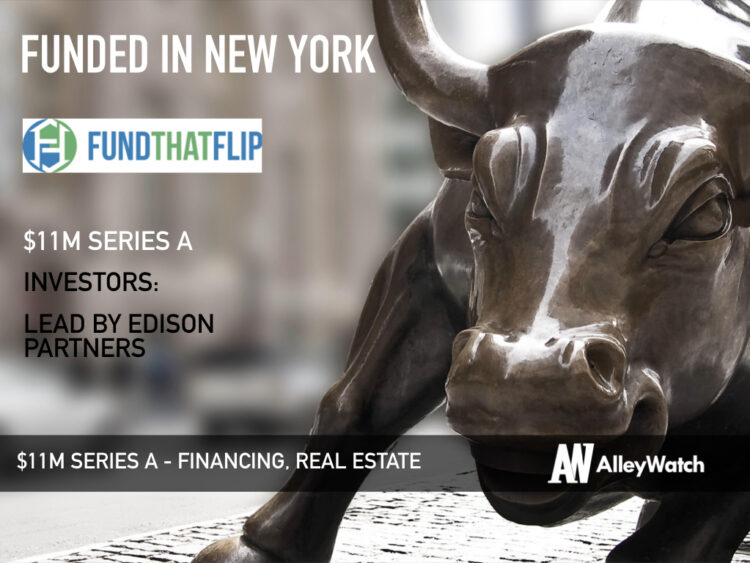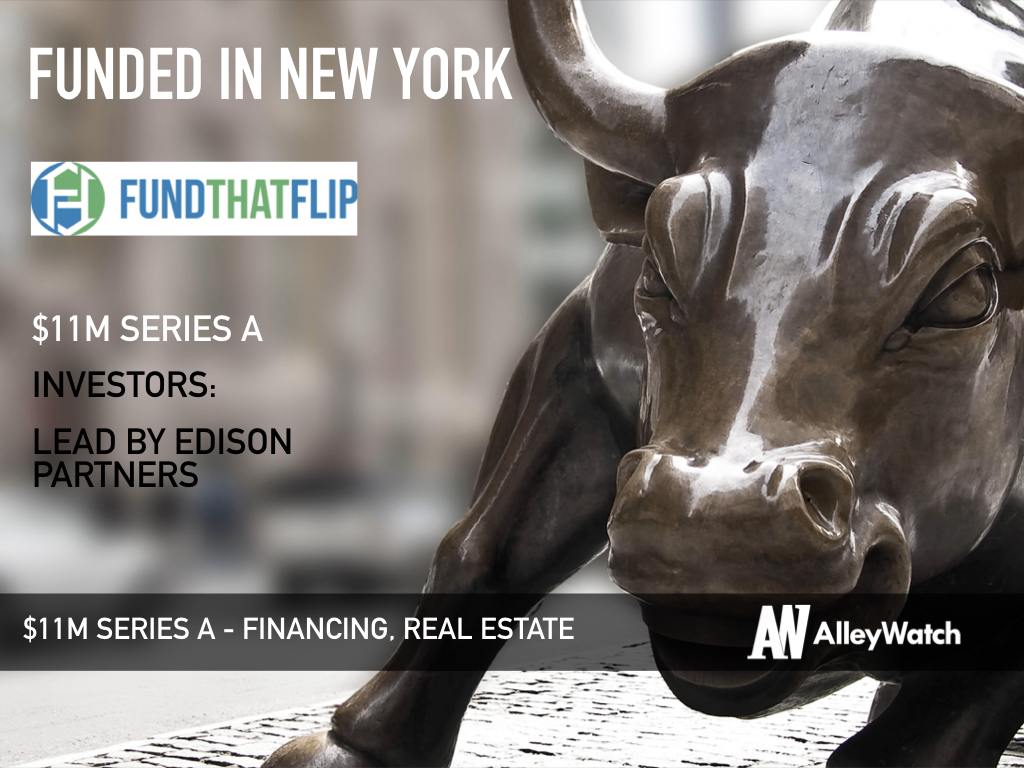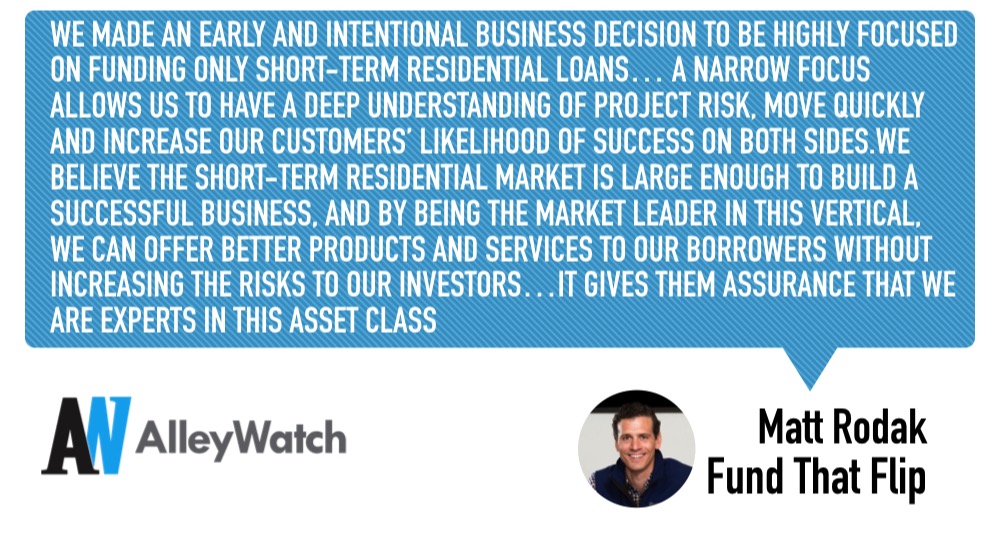Reality television shows like Fixer Upper or Rehab Addict have shown the promise and profits of real estate flipping or wholesale real estate investing. One of the biggest factors that determine the success of a project is the ability to finance the properties and associated renovations with capital efficiency. Fund That Flip is the lending marketplace that offers short-term financing to help experienced real estate investors buy and renovate residential properties. Investors can invest – a minimum of $5K – in these projects through the purchase of fractional shares of issued loans. Fund That Flip has strict underwriting criteria with only approximately 8% of applicants meeting requirements. The startup, launched in 2015, has doubled its business each year and has experienced 6,000% growth since its Seed round in 2016.
AlleyWatch caught up with Matt Rodak to learn more about the company’s success, future growth plans, and recent round of funding, which brings its total funding to $13M across four rounds.
Who were your investors and how much did you raise?
We raised $11M in Series A financing led by growth equity firm Edison Partners. Entrepreneur Roundtable Accelerator (ERA) also participated in the round.
Tell us about the product or service that Fund That Flip offers.
Fund That Flip is a marketplace lender focusing on residential real estate investment properties. We offer market-leading financing to help experienced real estate investors buy and renovate residential properties. Borrowers have transparent, streamlined access to flexible capital, allowing them to scale their business and focus on what they love to do: find and profitably rehabilitate homes.
On the lending side of the market, we provide accredited and institutional investors the ability to invest in this desirable asset class by purchasing fractional shares of the loans we originate, giving them access to an investment product that has historically been unattainable or difficult to invest in profitably. Investors earn 8-9% annualized yield and can easily diversify in terms of projects, borrowers and geographies.
 What inspired you to start Fund That Flip?
What inspired you to start Fund That Flip?
Growing up in the Canton, Ohio area, I started a small landscaping business in high school and ended up doing a lot of work for real estate investors. I got an opportunity to see how these investors would take one of the least attractive houses on the block and turn it into one of the nicest on the block. The economic value this generated—not only for the investor but also for the neighborhood— was very exciting to me. Seeing these transformations helped me realize back then that I wanted to be a part of real estate investing.
I sold the landscaping business and enrolled at John Carroll University, studying finance with that goal of getting into some form of real estate investing after graduation. However, I graduated in 2007, right as the real estate market was starting to crumble. Instead of diving straight into investing, I ended up taking a job with a large commercial property insurance company where I learned the ins-and-outs of assessing and pricing risk. After a few years cutting my teeth as an underwriter, I had the opportunity to move out to the Company’s corporate HQ to lead one of the division’s sales and marketing groups. In this role, I gained a lot of experience in sales processes, technology development and more generally, how to run a large organization. It was a truly fantastic opportunity, but I had the itch to get back into something more entrepreneurial.
So, I began pursuing my initial passion, which was real estate investing. During this process, I learned about the private lending market and saw an incredible opportunity to create the type of lender that I wish existed as an Investor. I believed that with the right technology and capital structure, we could create a better way to lend, one that put the unique needs of real estate investors first.
Having a little money saved up and being at the point in my life where I could take some chances, I moved down to NYC, started building the team, some baseline tech, and distribution and we went to market in 2015. Since then we’ve more than doubled our business each year and recently were named the 42nd fastest-growing company in the US by Inc. and the 4th fastest in our category for real estate.
How is Fund That Flip different?
We made an early and intentional business decision to be highly focused on funding only short-term residential loans. Having a narrow focus causes us to miss out on some good opportunities, but we decline these deals simply because they don’t fit within our appetite. Some of these properties are otherwise investable projects.
With a narrow focus, we are able to reduce the number of variables we need to understand before funding. This allows us to have a deep understanding of project risk, move quickly and increase our customers’ likelihood of success on both sides.
We believe the short-term residential market is large enough to build a successful business, and by being the market leader in this vertical, we can offer better products and services to our borrowers without increasing the risks to our investors. From the investors’ point of view, it gives them the assurance that we are experts in this asset class as we originate these loans.
It also means that investments are of similar risk profiles, which makes it easy for them to make intelligent investment decisions. All of this is seamlessly powered by our technology platform.
Even from the beginning, we were willing to sacrifice a larger market opportunity in favor of building a long-lasting company built upon specialization that provides value-add to both borrowers and investors. That’s proven true with this fundraise.
What market does Fund That Flip target and how big is it?
With the additional capital, we’re excited to take on and expand our market share of the trillion-dollar residential real estate investment industry.
On one side, we see enormous opportunity in the historically low levels of single-family home construction, which has created an affordability challenge for many willing homebuyers in the US. With the average age of a single-family home at 37 years old, millions of properties demand significant investment to meet the preferences of modern home buyers. Real estate redevelopers who leverage our financing to renovate aging or neglected properties are able to deliver a like-new home at an attainable price point.
There are also a number of factors that have led to supply constraints, giving rise to opportunity for recycling current housing units. According to economic and historical data, we are underbuilt to the tune of about 2.5 million housing units. With population and household formation on the rise, there’s an undersupply of affordable housing for people who are willing to be buyers, and in particular for millennials—the largest working and homebuying generation. A recent study found that 90% of millennials plan on buying a house, leading to a pressing need for housing units. Finally, with less land available, higher building materials costs and a labor shortage, there’s a lot of pressure on new home builders to quickly add supply inside price points that buyers want. This creates a ton of opportunity for our savvy developer customers to do renovations and infill projects and maintain some pricing power.
What’s your business model?
Like many lenders, we make money via origination fees charged to the borrower. We also take an interest rate spread. That means if we charge 10% to a borrower, we may pass 9% through to the investor, capturing the 1% in the middle.
How has the business changed since we last spoke in 2016 after Fund that Flip’s seed round?
Our team has gone from 5 to 45. We opened an office in Cleveland, where a majority of our team now works and resides. We’ve expanded our geographic footprint to 18 states. We’ve rolled out several new products, including a point of sale property and casualty insurance offering to borrowers. And way too many technological improvements to list!
Our team has gone from 5 to 45. We opened an office in Cleveland, where a majority of our team now works and resides. We’ve expanded our geographic footprint to 18 states. We’ve rolled out several new products, including a point of sale property and casualty insurance offering to borrowers. And way too many technological improvements to list!
What was the funding process like?
Not that the process is ever easy, but we were surprised at the interest we received from a variety of different types of investors. After our seed round in 2016, we were determined to scale the business rapidly but also do so in a way that allowed us to reach break-even. We accomplished over 6,000% growth in that time period while also breaking even. It turns out this is something a lot of investors like.
What are the biggest challenges that you faced while raising capital?
The market does not currently look favorably upon lending businesses. There is a fear that we are the top of the credit cycle and that the next few years could prove challenging. While this may be true, we also believe that there is opportunity in any market so long as we’re well-positioned within our space. Our ability to develop positive unit economics and grow on minimal capital was a big part in helping us get over that objection.
What factors about your business led your investors to write the check?
I don’t want to speak for them but we’re tackling an enormous market, we’ve proven our ability to execute, and we’ve collected a lot of data to inform how we invest this capital to earn a return. A lot of the business has been de-risked and there is still a tremendous amount of upside.
What are the milestones you plan to achieve in the next six months?
We will be hiring and onboarding new teammates to help us continue to grow. We’re also in the process of developing new residential loan products for both borrowers and lenders, which will be a big part of our future growth plans. We expect to have these products in market by Q1 2020.
What advice can you offer companies in New York that do not have a fresh injection of capital in the bank?
Get to profitability – or at least break-even – as quickly as you can. The best leverage you can have with investors is telling them you don’t need their money. Not only that, but it forces you to be more creative and prove to yourself that the business has the potential to have positive unit economics.
Where do you see the company going now over the near term?
We’re laser-focused on building the predominant platform that empowers real estate investors to operate their entire business more profitably. For now, that means showing up, doing what we say we’re going to do, listening to customer needs, and applying our resources and unique capabilities to create more value for both borrowers and lenders.
What’s your favorite restaurant in the city?
I’m from Ohio and grew up with a Polish great-grandmother who made the best perogies. The closest I’ve found to her recipe is Veselka, so I think I have to go with that.





